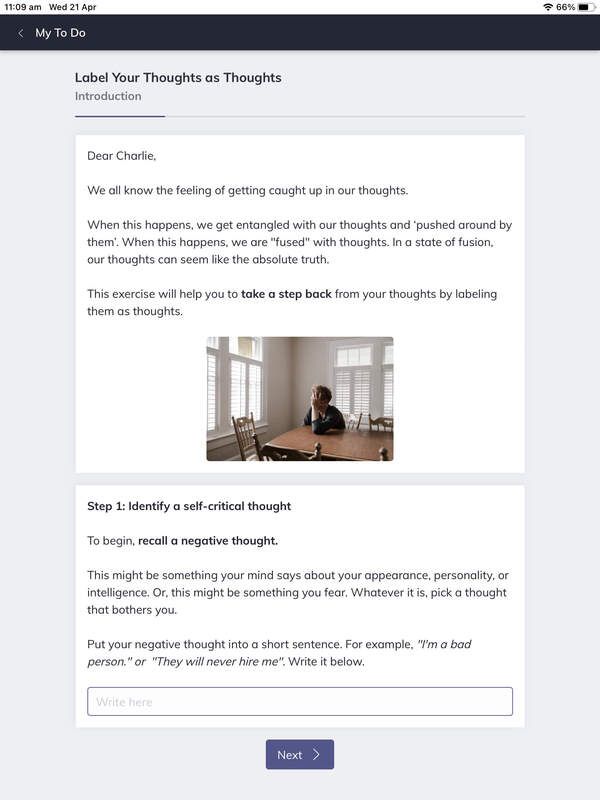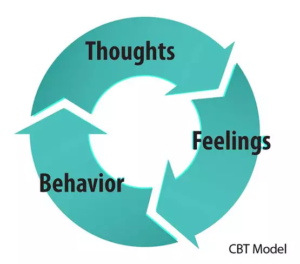What Is Positive CBT? Positive Psychology in Therapy
 What comes to mind when you hear the word “therapy”?
What comes to mind when you hear the word “therapy”?
Most people have the vision of what we see in the movies, a doctor seated in his chair, with a pen and pad in hand, while the client lies down and talks about his feelings.
Although that is indeed a kind of therapy, that does not give us the whole picture of what therapy is and what it can be.
There are many kinds of “therapy” in the field of Psychology. Cognitive Behavioral Therapy, more popularly referred to as CBT, is one of them. CBT has been around since the 20th century and is known to be quite effective for people with anxiety, specific behavioral problems, and even certain kinds of phobia.
If CBT is often used with specific challenges, what exactly is Positive CBT?
Positive Psychology has continuously developed since it was first introduced. Part of its growth uses other branches of psychology and different types of therapy to help people flourish and thrive. CBT plays a significant role in the development of positive psychology as it is often used with topics like optimism, gratitude, and resilience, among many others.
Read on to find out how Positive CBT is based on traditional CBT, how they are like each other, and what makes Positive CBT different from its forerunner.
Before you continue, we thought you might like to download our three Positive CBT Exercises for free. These science-based exercises will provide you with detailed insight into Positive CBT and give you the tools to apply it in your therapy or coaching.
This Article Contains:
- What is Positive Cognitive Behavioral Therapy?
- Positive CBT and Its Relationship with Other Theories and Therapies
- Positive CBT vs. CBT: What’s the Difference?
- Fredrike Bannick on Practicing Positive CBT
- Positive CBT Interventions & Techniques
- 3 Positive CBT Exercises
- Recommended Articles from our Blog
- A Take-Home Message
- References
What is Positive Cognitive-Behavioral Therapy?
Positive Cognitive Behavioral Therapy (CBT), as the name suggests, is founded on the main concepts of CBT.
The CBT model was initially used to help individuals with specific problems, such as depression and anxiety. It helps individuals understand their maladaptive thoughts, which were often found to be the source of their problems (Rush & Beck, 1978). It focuses on the problem, what causes the problem, and possible interventions for the problem.
Positive CBT, on the other hand, shifts therapy towards focusing on what is right with a person and on what is working, instead of focusing on all the problems a person face and what is not working (Bannink, 2017).
Positive CBT and Its Relationship with Other Theories and Therapies
Positive CBT is based on several different theories and therapies. It draws on concepts from CBT, using both Cognitive Therapy and Rational Emotive Behavior Therapy. It also uses concepts from positive psychology, Solution-Focused Brief Therapy, and the “upward arrow” of Functional Behavior Analysis (Bannink, 2017).
Cognitive Behavioral Therapy (CBT)
CBT seeks to help individuals relieve themselves of psychological stress through studying and correcting faulty beliefs, which then leads to more appropriate reactions and responses (Rush & Beck, 1978). It has been known to help with problems involving depression, anxiety, substance use, eating disorders, and even issues in relationships.
Simply put, the CBT model is summed up by the figure below:
Figure 1. CBT Model (McLeod, 2019)
The model shows the basic premise of CBT – our thoughts, feelings, and actions affect each other. Our psychological problems can partly be traced back to two things: faulty thinking patterns and unhelpful learned patterns of behavior (American Psychological Association, n.d.).
CBT highlights the importance of examining our thoughts, discovering how these beliefs make us feel, and how these affect our actions. Our self-talk, or mind-chatter, can give us information on what these beliefs are and if they are faulty or skewed.
Positive CBT also looks at our thoughts, feelings, and behavior. Just like traditional CBT, it seeks to understand the underlying thoughts and feelings linked to these actions. Its focus is not where things are faulty and skewed, but where things are going well. It finds opportunities to create a positive shift in our beliefs and thoughts so that it can change the way we experience life.
There are two types of therapies that are usually referred to as CBT: 1) Dr. Aaron Beck’s Cognitive Therapy, and 2) Dr. Albert Ellis’ Rational Emotive Behavior Therapy.
Cognitive Therapy (CT)
In the 1960s, Dr. Beck conducted experiments to test different concepts of depression (“History of Cognitive Behavior Therapy,” 2019). He found that individuals with depression had a pattern of negative thoughts which often recurred automatically. These negative thoughts often include the self, the future, and the world.
This type of CBT helps clients to challenge their dysfunctional thoughts, try out different possible beliefs and interpretations, and use those that are most beneficial to the client.
The CT model can be adapted in Positive CBT as it looks at emotional, behavioral, and physiological reactions that occur due to automatic thoughts and images. Positive CBT helps clients identify positive thoughts that fuel helpful and beneficial reactions. In doing so, clients can consciously choose to focus on these constructive thoughts, helping them to respond more positively and appropriately in a particular situation.
Rational Emotive Behavior Therapy (REBT)
The goal of REBT is to help the individual identify the irrational belief, challenge these beliefs, and change them into more rational ones. Dr. Ellis created the ABC Model (Ellis, 1957, 1962, as cited in McLeod, 2019.) which looks at the following:
- Activating Event – this is what happens to us or around us
- Belief – these are our interpretations, perceptions, assumptions, and expectations in a given situation
- Consequence – this how we feel and behave
Our Beliefs play an important role in how we end up feeling about a situation and how we choose to react to that event. We often respond without paying attention to what drives us, our Beliefs, to behave that way.
In 1987, the ABC model became known as the ABCDE model (Ellis and Dryden, 1987, as cited in Jorn, 2018.), adding two more steps, Dispute, and new Effect.
Dispute means to look for arguments and evidence that will go against our irrational beliefs. The new Effect is now the outcome after disputing our thoughts, thus resulting in a shift in our expectations.
Positive CBT takes this ABC model a step further and helps individuals respond more positively even when things go wrong. In 2006, Martin Seligman adapted Ellis’ model and used ABCDE to explain how people can learn to be more optimistic.
Adversity is the event or situation that happened. Clients are encouraged to include details of that situation and to be specific and objective. It looks at facts and truths instead of interpretations.
Belief is now the thoughts that run through the person’s mind during the situation.
Clients are invited to write down all the things they can remember without filtering these thoughts. Consequence includes how the client felt and how they reacted during the adversity. Clients are asked to be specific in describing their emotions, reactions, and actions. After identifying the consequences, clients are then asked to look at how their consequences align with their beliefs and if these make sense.
During the Disputation stage, clients are challenged to generate evidence to demonstrate how some of their beliefs are inaccurate. They are also asked to look at optimistic possibilities and alternative beliefs that are more accurate to the given adversity. Clients can dispute beliefs through different ways like:
- how a belief is not entirely true,
- what is more accurate compared to specific identified beliefs,
- possible outcomes for each belief,
- more appropriate responses given a specific belief,
- and finding possible solutions.
Energization shifts the client’s focus on how disputing inaccurate beliefs changes how they feel, respond and act. Often, the client feels relief, becomes more optimistic and can choose more helpful behavior given a specific situation. It also helps them to focus on the solutions that they were able to come up with during disputation.
You can also read our additional article on REBT Techniques and Exercises.
Solution-Focused Brief Therapy (SFBT)
SFBT was developed by Steve de Shazer and Insoo Kim Berg in the 1970s (“What is Solution-Focused Therapy,” 2019). Most kinds of therapy focus on the individual’s problem and what happened in the past.
SFBT, on the other hand, focuses on the future, is goal-oriented, and seeks to find solutions. The approach makes two assumptions; every individual knows what they need to make their life better and that they have the minimal skills to create solutions for themselves.
Positive CBT often uses SFBT techniques to help individuals generate solutions and possibilities. Here are a few examples of SFBT techniques:
- Previous Solutions – The therapist asks questions about other times when the client was able to solve other problems. A possible question asked is “What worked in that problem?”
- Present and Future-focused Questions – Instead of asking questions related to the past, the client is encouraged to look at what is currently working. The therapist also asks how the client envisions himself in the future. An example of future-focused questions is, “What will you be doing in a week that will let you know you are making progress?”
- Compliments – These helps validate what the client is doing and what he is going through. Compliments are often delivered through appreciative questions like “How did you do that?”
- Do More of What is Working – The therapist invites the client to try things out or to experiment by doing more of what has worked for him in the past.
- Scaling Questions – A scale of 0 to 10 is used to help clients assess the situation they are in, evaluate and track their progress, and find out what their next small step can be.
Positive CBT practitioners, through SFBT techniques, help their clients make positive changes by focusing on what is in their control and what they can do, instead of what they cannot do.
Functional Behavior Analysis (FBA)
A functional assessment studies behavior but also looks beyond the specific action. The approach is often used to understand why a person acts a certain way (Morin, n.d.). It seeks to find factors that may be associated with the behavior, as well as factors that are related to when the behavior does not occur (Bannink, 2017).
Bannink also explains that during an FBA, a problem is analyzed using the ABC model. The ABC factors indicate the likelihood that the problematic behavior will or will not occur. The FBA process consists of five steps (Morin, N.D.; Department of Special Education Lincoln Public Schools, 2006):
- Defining the Behavior – A team identifies the problematic behavior that needs to be addressed.
- Collecting Data – The goal of this step is to learn more about the behavior by looking at different factors related to the behavior. The ABC model can be used in this step.
- Developing a Hypothesis – The team creates an educated guess, based on the data gathered, about the function, reasons, and purpose of the behavior.
- Developing an Intervention – An intervention plan is created to help make necessary changes in the environment that will address the problematic behavior.
- Evaluating the Plan – Once the intervention is set, the team evaluates its effectiveness and makes appropriate adjustments when needed.
In Positive CBT, the different FBA steps are often used together with the CBT and SFBT techniques. Instead of looking at problematic behavior, the FBA process can highlight behavior that works for the client, helps him cope, and can be repeated to lead him to success.
As discussed, the main models and concepts from CBT, SFBT, and FBA are often used in Positive CBT with a shift in focus. The focus of CBT will be discussed in the next section as it explores the difference between traditional and Positive CBT.
Positive CBT vs. CBT: What’s the Difference?
Positive CBT emerged from traditional CBT from the desire to help clients gain more substantial and long-term benefits from therapy (Bannink, 2017). These two types of therapy have a similar goal – to bring about the desired change in the client’s life.
One significant difference between Positive CBT and its traditional predecessor is the type of thoughts and beliefs it focuses on. Traditional CBT focuses on problem-solving. It looks at what’s wrong and finds possible interventions to fix it. Often, it focuses on the client’s limitations and deficiencies.
These findings are supported by the CBT literature, which shows an emphasis on the factors that promote and sustain a problem (Kuyken, Padesky, & Dudley, 2009, as cited in Bannink).
Positive CBT, on the other hand, focuses on helping the client feel positive emotions, be engaged at home and work, have meaning, experience accomplishments, and maintain positive relationships (Seligman, 2011). It highlights the factors that help boost the individual’s wellbeing and allows them to flourish. It seeks to help the individual look at his talents, strengths, abilities, experience, and resources.
What will happen when we think about what is right with people rather than fixating on what is WRONG with them?
Donald O. Clifton
Positive CBT, as explained by Bannick (2017), is also grounded in a strengths-based approach to helping people. This perspective emphasizes that the individual is capable and has the resources within him to deal with conflicts, effectively cope with stressful situations, and find solutions to his problems.
This approach also encourages a collaborative process between therapist and client. It encourages the client to explore his strengths and decide how he can apply these to specific areas of his life.
Bannick also states that Positive CBT uses an “upward arrow technique,” which is different from traditional CBT’s “downward arrow.” The “downward arrow technique” helps clients to identify thoughts and beliefs that lead to negative feelings and behaviors.
It is also problem-focused and often looks at what is wrong. Specific questions like “What’s bad about that?” “What’s not working?” “What’s not helping?”, and “What is the worst thing that can happen?” are examples of downward arrow questions that are used in traditional CBT.
On the other hand, the upward arrow technique asks questions like, “What would you like to change?” “How will you feel once that situation changes?” “What difference will that make in your life or your situations?”, and “What is the best-case scenario?” These focus on the client’s positive thoughts and reactions. It also allows the client to seek possibilities and find exceptions to the problem.
Fredrike Bannick on Practicing Positive CBT
Practicing Positive CBT generally has similarities with traditional CBT practices. Therapy tends to be a collaborative effort between the therapist and the client. They work together to identify maladaptive beliefs and behaviors that need to be changed, establish a goal, and work on it.
On the other hand, Positive CBT puts more emphasis on the client’s role in therapy. Bannick (2017) shares essential elements which practitioners must be mindful of when engaging with clients. These six elements are discussed below:
- Therapeutic Alliance – The therapist and client agree on collaborative therapeutic engagement. The therapist facilitates a positive partnership and monitors the client’s progress. The client takes an active role in designing his interventions and takes accountability for the change he wants to make.
- Build Rapport – The positive alliance starts with the therapist’s questions, which are often geared towards uncovering the client’s strengths. The questions can also serve as an icebreaker and a way to get to know the client more.
- Acknowledge Problems – Positive CBT does not ignore problems. Most clients may find it beneficial to talk about their problems. Positive CBT therapists listen to these stories and acknowledge what the client is sharing. The therapist does not probe further into the issue; instead, they then focus on helping the client to view the problem differently and uncover strengths and possibilities.
- Shift to Strengths and Solutions – The therapist asks questions to guide the client to focus on solutions, strengths, and available resources. Therapists may make use of different SFBT techniques, such as focusing on what is working and looking for exceptions to the problem.
- Set Goals – This is a crucial element in the therapeutic process as it provides the client with the opportunity to change. The therapist can also use goals as a way to shift the client’s focus to possibilities, instead of problems.
- Positive Self-Monitoring – The client is encouraged to monitor his progress, strengths, and exceptions to the problem. Therapists can use the FBA methodology to help the client with self-monitoring. A Positive FBA approach is used when asking questions instead of the traditional FBA. Examples of Positive FBA questions, which may also seem like SFBT questions, are “When things are going well, what have you noticed that you do differently?” and “If a miracle happens, and your problems are no longer your problems, what will be the first thing you notice that you are doing differently?”
Positive CBT Interventions & Techniques
As mentioned earlier, Positive CBT is based on CBT, SFBT, and uses FBA. The interventions shared in this section use one or a combination of these traditional interventions. Positive CBT takes these techniques and shifts them into focusing on the individual’s strengths and possible solutions, rather than what is wrong.
The “upward arrow technique,” mentioned earlier, is a kind of Positive CBT intervention therapists often use. Bannick (2017) also shares several other techniques that can be used: changing the viewing, changing the doing, changing the feeling, homework tasks, and evaluation.
Change the Viewing
One of the most significant findings in Psychology, in the last 20 years, is that individuals can choose the way they think.
Martin Seligman
According to Bannick (2017), “changing the viewing” encourages clients to change something in the way they view the problem, how they do the problem or both. This intervention works on the premise that one cannot expect different results by engaging in the same thing.
This process focuses on helping an individual change what they pay attention to, as well as their thoughts and beliefs. Bannick shares five interventions in this process:
- Acknowledge Feelings and Experience – Clients are given the space to acknowledge how they feel and what they experienced in the past. They are encouraged to explore helpful stories and discover a kinder and more compassionate view of themselves and of the situation (Gilbert, 2010, as cited in Bannick).
- Pay Attention to Something Different – Therapists guide the clients to pay attention to past success stories instead of problems and failures. This helps the client shift the way they see themselves, which can result in a more positive perception of the self.
- Focus on What Clients Want for the Future – Instead of focusing on what they do not like in their present situation or the past; therapists help their clients focus on what they want in the future. Clients set goals and focus on what they want to change. This helps them see the possibilities instead of fixating on the problems.
- Challenge Unhelpful Beliefs – Therapists use Positive CBT to guide clients to find helpful thoughts and adaptive behavior that can increase their positive experiences of themselves and the world. The process helps them find thoughts and behaviors that the client already uses. An emphasis is placed on repeating these adaptive cognitions and actions.
- Use a Spiritual Perspective – Bannick cites O’Hanlon’s (2000) three Cs of spirituality: connection, compassion, and contribution. Therapists invite clients to explore connecting with something bigger beyond themselves. The client also discovers ways that he can be more compassionate or kinder, towards himself and others. Lastly, the clients are encouraged to contribute and unselfishly be of service to others. These three Cs have been found the be sources of resilience.
Change the Doing
Positive CBT also studies the pattern of behavior and finds ways to break that pattern. Instead of looking for reasons why the problem exists, clients assess what they are doing to solve their problem.
The first intervention used to “change the doing” is to pay attention to patterns of behavior. These patterns can be things that happen on their own or involve other people too. They are invited to change a part of their repeated actions through two specific techniques:
- Paradox – Therapists invites the client to explore the problem and to find ways to intensify it or to make it happen more frequently. The client tries to make it happen deliberately. This allows the client to accept that there is a problem, and maybe even let it play out.
- Link New Actions – Clients identify something they can do when the problem occurs. A new behavior is introduced to break the problematic pattern. This new action is ideally something that will turn out to be good for them, which may be a challenge too.
The second intervention is to pay attention to the behaviors the client engages in when things are going well. This gives the client the space to find exceptions in the problem, times when the problematic behavior pattern was not present.
Once the client finds this exception, the client is invited to explore what they were doing then, what was happening during that time, and what tells them that the problem behavior has ended or is about to end. The client is encouraged to engage in these helpful actions intentionally, just as they did during the times when the problem was not present.
To change the doing, clients must find ways to do something differently. Often, the problematic behavior persists as a problem because the client does the same things again and again.
Through Positive CBT, therapists trust that the solutions are already available to the clients, that clients are the best people to know what works and what does not, and that clients can make changes in the way they behave because they have already made changes in the past.
Change the Feeling
Grant & O’Connor (2010) found that when the questions in therapy focus on problems, negative affect decreases, but does not necessarily increase positive affect. On the other hand, questions that focus on possibilities and solutions help reduce negative affect but also increase positive affect. Individuals also gain a better understanding of their problems.
Positive CBT focuses on positive emotions by using questions related to hope, success, strengths, and competencies. Fredrickson’s (2009) broaden-and-build theory suggests that positive emotions allow individuals to broaden their awareness of their beliefs and behaviors.
A focus on positive emotions also encourages new thoughts and actions. Therapists ask open-ended questions that focus on what the client wants, as well as on what is already working and what can help the client.
Through using CBT, SFBT, and FBA, and applying these techniques in the context of Positive CBT, therapists can help clients focus on the skills and resources available to them.
Homework

In Positive CBT, therapists will often focus on teaching their clients new principles and skills to help them manage their cognitions, emotions, and behaviors in daily life.
After therapy, the client will then practice the specific interventions that were explored during the session,
Therefore, a Posivite CBT approach assumes that positive change most often happens in-between therapy sessions.
With the rise in digital technologies, such as smartphones and blended care e-therapy platforms like Quenza (pictured here), the prescription of take-home interventions is becoming increasingly more common and convenient.
Likewise, many of the interventions being applied by Positive CBT practitioners are drawn from well-established bodies of research and come prepackaged in toolkits and libraries. For instance, Quenza includes a pre-programmed library of digital homework activities for practitioners to draw on, which includes a range of meditations, cognitive defusion exercises, and reflections that suit a Positive CBT approach.
Like traditional CBT, Positive CBT also makes use of behavioral experiments. These encourage clients to focus on what is right and working. Here are a few examples of behavioral tests and how they are used in Positive CBT:
- Experimental manipulation of the environment – The client is to try something new, something different from what he usually does in a specific setting. Like previous techniques, the client experiments by finding exceptions to the problem, then intentionally trying these actions that contributed to that exception.
- Observational experiments – The client gathers information and looks for evidence that supports their beliefs. In this case, clients are asked to find evidence for their positive thoughts, instead of their negative beliefs. These experiments help clients through attention bias, which increases our chances to see positive proof when we focus on our positive thoughts.
- Discovery-orientation experiments – The client is invited to collect data by exploring what can happen if he engaged in a specific behavior. The client may also try out the behavior to obtain the necessary information. One way of using a discovery-oriented experiment is by inviting the client to pretend that they are already in the future they want for themselves. The client then explores what he is doing in that future, what is different, how they are feeling and acting, and even what their relationships look like in that future.
It is important to note that homework is given if the client agrees to it and sees the value in it. Homework will more likely have an impact if the client acknowledges how they can benefit from doing such homework.
3 Positive CBT Exercises
If you’re looking for more Positive CBT resources, be sure to download our free Positive CBT Exercises Pack.
This free resource features a selection of our favorite tools from the Positive Psychology Toolkit©, an online library of over 400 exercises, guides, and interventions designed to support helping practitioners in the positive psychology community.
Here’s what you’ll find included in the pack.
1. Solution-Focused Guided Imagery
In this exercise, the therapist follows a detailed sequence of steps to help clients imagine a recurring problem in terms of its behavioral manifestations and consequences. The therapist then invites the client to imagine what reality would look like to themselves and others if this problem were miraculously solved.
As part of the exercise, clients will explore small actions taken in the past that have helped them work toward resolving their recurrent problem. connect deeply to their strengths and resources, energizing them to engage in coping strategies even when they are in crisis or feel stuck.
2. Reframing Critical Self-Talk
In this exercise, clients explore common manifestations of self-criticism and how they form the antithesis of self-compassion.
Clients will commit to small actions that help them become more mindful of self-critical talk. Once they have gained this awareness, they will work on rephrasing this self-talk to be more compassionate and constructive.
3. Strengths Spotting by Exception Finding
This exercise helps clients explore the strengths and resources at their disposal when dealing with a presenting complaint or problem.
To do this, clients begin by identifying an ‘exception’ to their complaint or problem–a time when it did not occur (or occurred with less severity). The client then explores the circumstances around this exception and the strengths they drew on to lead themselves to a positive resolution in the past that may be useful in the present.
Get the exercises for free by downloading the free pack today.
Recommended Articles from our Blog
Below is a list of articles you can check out to learn more about Positive CBT and CBT:
- CBT Explained: An Overview and Summary of CBT
- Albert Ellis’ ABC Model in the Cognitive Behavioral Therapy Spotlight
- 25 CBT Techniques and Worksheets for Cognitive Behavioral Therapy
- Learned Optimism: Is Martin Seligman’s Glass Half Full?
A Take-Home Message
Positive CBT uses the same techniques and models of traditional CBT. It also makes use of techniques and interventions from SFBT and FBA. The Positive CBT process helps individuals to focus on what works and what is right about them and the situation they are in. It uses techniques and activities that are used in other kinds of therapies but always focusing on the positive.
Interventions using Positive CBT have helped clients with gratitude, optimism, mindset, and resilience.
You can’t go back and change the beginning, but you can start where you are and change the ending.
C.S. Lewis
While looking at the past and evaluating our problems is helpful, Positive CBT promotes that longer-lasting benefits are brought about by focusing on what we can change, which is our present and future. We can achieve these changes by paying attention to our helpful thoughts and beliefs, as well as our adaptive behaviors.
Once we have identified our abilities, resources, and strengths, Positive CBT encourages us to do more of these and make small shifts in the way we do things to achieve the future we want for ourselves.
We hope you enjoyed reading this article. For more information, don’t forget to download our three Positive CBT Exercises for free.
- American Psychological Association, n.d. What Is Cognitive Behavioral Therapy?. Retrieved from https://www.apa.org/ptsd-guideline/patients-and-families/cognitive-behavioral
- Bannink, F. P. (2012). Practicing positive CBT: From reducing distress to building success. Chichester, West Sussex: Wiley-Blackwell.
- Cognitive Model. (2019). Retrieved from Beck Institute for Cognitive Behavior Therapy Website: https://beckinstitute.org/cognitive-model
- Grant, A. & O’Connor, S. (2010). The differential effects of solution-focused and problem-focused coaching questions: A pilot study with implications for practice. Industrial and Commercial Training. 42. 102 – 111.
- History of Cognitive Behavior Therapy. (2019). Retrieved from Beck Institute for Cognitive Behavior Therapy Website: https://beckinstitute.org/about-beck/our-history/history-of-cognitive-therapy
- Jorn, A. (2018). Rational Emotive Behavior Therapy. Psych Central. Retrieved from https://psychcentral.com/lib/rational-emotive-behavior-therapy/
- McLeod, S. A. (2019, Jan 11). Cognitive behavioral therapy. SimplePsychology. Retrieved from https://www.simplypsychology.org/cognitive-therapy.html
- Morin, A. (2019). Functional Assessment: What it is and how it works. Understood. Retrieved from Understood Website: https://www.understood.org/en/school-learning/evaluations/
evaluation-basics/functional-assessment-what-it-is-and-how-it-works - Rush, A. J., & Beck, A. T. (1978). Cognitive therapy of depression and suicide. American Journal of Psychotherapy, 32(2), 201–219. Retrieved from http://search.ebscohost.com/login.aspx?direct=true&db=psyh&AN=1979-24065-001&site=ehost-live&scope=site
- Seligman, M.E. (2011). Flourish. New York: Free Press.
- Seligman, M.E. (2006). Learned optimism: How to change your mind and your life. New York: Vintage Books.
- What is Solution-Focused Therapy?. 2019. Retrieved from Institute of Solution Focused Therapy Website: https://solutionfocused.net/what-is-solution-focused-therapy
Let us know your thoughts
Read other articles by their category
- Body & Brain (49)
- Coaching & Application (57)
- Compassion (26)
- Counseling (51)
- Emotional Intelligence (24)
- Gratitude (18)
- Grief & Bereavement (21)
- Happiness & SWB (40)
- Meaning & Values (26)
- Meditation (20)
- Mindfulness (45)
- Motivation & Goals (45)
- Optimism & Mindset (34)
- Positive CBT (28)
- Positive Communication (20)
- Positive Education (47)
- Positive Emotions (32)
- Positive Leadership (18)
- Positive Parenting (4)
- Positive Psychology (33)
- Positive Workplace (37)
- Productivity (17)
- Relationships (46)
- Resilience & Coping (36)
- Self Awareness (21)
- Self Esteem (38)
- Strengths & Virtues (32)
- Stress & Burnout Prevention (34)
- Theory & Books (46)
- Therapy Exercises (37)
- Types of Therapy (64)






What our readers think
Thank you for this article. I have heard of positive psychology then it became quiet for awhile. Great comeback with Beck’s work! I really needed to hear this for my resilient recovery! I kept on hearing about negative techniques that I was going to give up. It is hard to work on a half full glass of water concept. This really brings to light. Plus. With Beck’s death, this is a great contribution to his country for peace. (Sorry I had to bring that up.) And. I hope you can bring peace too to Philippines people under the circumstances and all!
I would have to saw there is a trend to focus on the present and future rather than the pastand present.
As a CBT therapist there seems to be no difference between the Positive CBT and regular CBT. Within my practice I encompass all of what has been stated, building a relationship is fundamental to any therapeutic practice, Asay and Lambert identified this as an essential element to a variety of therapeutic modalities.
This wonderful. I am seriously interested in positive approaches and techniques , believing that this is a better approach than problem focused